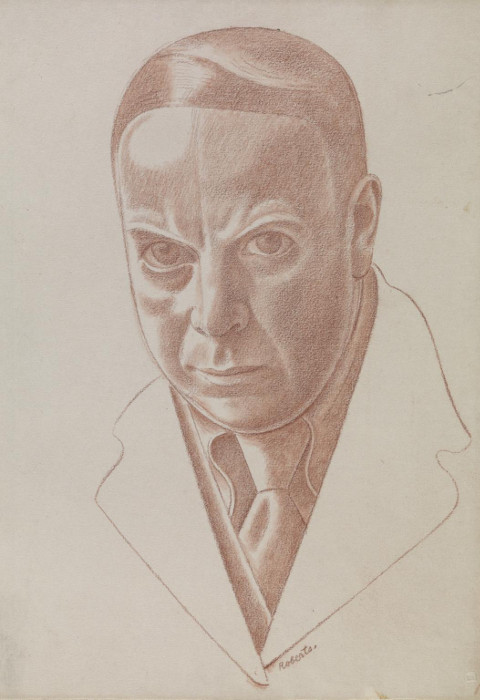AN ENGLISH CUBIST
WILLIAM ROBERTS:
Portrait of the Artist
This piece and the accompanying self-portrait were first published in Art News and Review 1, 20 (5 November 1949). © The Estate of John David Roberts.

After attending the classes of visiting Art Mistresses, where I drew plant forms, the nose of Michael Angelo's David, the ear from Donatello's St. George, and the lips of some nameless Greek goddess, in dismay I found myself, at the age of fifteen, apprenticed for seven years to a firm of commercial designers in the vicinity of Billingsgate Market. Escaping at the end of a year from the bonds of this apprenticeship, I reached the Slade School about the start of my sixteenth year.
In those gloomy studios in Gower Street, upon whose walls hung the school achievements of John, Orpen, and others of renown, I worked with students, many of whom were later to become important in English painting. We were continuously exhorted by Professors Tonks and Steer to study Ingres and Degas: yet how much, too, could we learn from Stanley Spencer and Gertler, drawing at our side!
Events of importance to Slade students were the introduction by Roger Fry of his Post Impressionists into England; the ending of Picasso's 'Blue Period', and the birth of Cubism.
Whether Pablo developed his abstractions from Cézanne, or the doodlings of his friend Max Jacob, these experiments certainly had a powerful influence upon the art centres of Europe. At the Slade there were some who grew restless upon their donkeys, this new 'Cubism' disturbing their vision. For myself, the 'Angularities' of Picasso's Guitarists made me forsake for many a long day the succulent 'Rotundities' of Ingres' Odalisques. Tonks was in despair! But among his Old Masters at the print room of the British Museum,Laurence Binyon held out a guiding hand. He said that Roger Fry at his Omega Workshops needed assistants. Clutching my drawing board, I abandoned the 'Life Room' and hurried across Tottenham Court Road to the Omega in Fitzroy Square to decorate, for the Impressario [sic] of Post-Impressionism, table tops and fabrics with Cubist designs. There had passed from the Omega workshops shortly before my arrival, a bunch of the most turbulent 'Apprentices' that ever a Master Craftsman could wish to employ. Its members, including Etchells, Wadsworth, and Hami[l]ton, under the leadership of one of their number, Wyndham Lewis, had suddenly struck work, presented Fry with a 'Manifesto', and marched off to set up a rival establishment under the title of 'Rebel Art Centre', in the very heart of Bloomsbury.
This hostile camp, on the alert, quickly learned of the fresh recruit at the Omega and soon, following an invitation from their leader, I passed over to the Rebels.
In 1912 the Italian Futurist Group, led by Marinetti, held an exhibition in London, and made Art Manifestos fashionable. Emulating them, Lewis, assisted by Ezra Pound, in the early months of 1914 formed the 'Vorticists' from his little party of Rebels. A notable exhibition of our painting at the Doré Gallery in Bond Street followed, whilst in addition to this the clamour set up by our 'Blasting' held any lurking 'Conspiracies of Silence' in their proper place. With intermittent 'Blasts we continued to whirl', until in 1915 Lord Derby claimed us for 'Blasting' operations of a different sort in Flanders. From a 'Rebel' I became an 'Official' Artist, and painted a Gas Attack for Canadian War Records and a Shell Dump for the Ministry of Information. Under the title of 'Group X' an endeavour was made to bring the Vorticists together again, but after one exhibition at the Mansard Gallery, the Group disintegrated. When Mussolini was an example to all statesmen and newspapers had not yet printed Hitler's name, I joined a group of painters known as the London Artists' Association. This Association was backed by a nucleus of wealthy industrialists and financiers called the guarantors, presided over by Maynard Keynes, an endeavour as it were to transform an artist into a commodity with definite gilt edging. Through my exhibitions at the Cooling Gallery I was already well on the way to being considered a safe risk by the guarantors when the resignation of Duncan Grant caused Samuel Courtauld to decide there was no point in continuing the scheme any longer.
Home page | Chronology | Bibliography | Collections | Exhibitions
News | Gallery | Auction results | The artist’s house | Contact
List of works illustrated on the site
Catalogue raisonné:
chronological | alphabetical